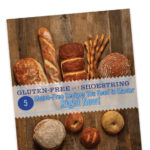Since the release of Gluten Free on a Shoestring Bakes Bread, I have fielded lots and lots of questions over email, on Facebook daily, and in the two Facebook Q&A sessions we have done. You've really rolled up your sleeves and gotten in there! In an effort to get you answers as quickly as possible, I have summarized the questions and answers here on this page. I will continue to update this page regularly as new FAQs arise. And from now on, when you send me these questions, you’ll probably get a link to this blog post in response. :)
- Q#1. If I want to make one of your gluten-free flour blends, I would prefer to make 10 cups at a time and have it handy. But how do I know that I'm getting the right proportion of ingredients in every cup? How do you do it?
- Q#2. Is it possible to overwork the dough? How can you tell when to stop?
- Q#3. Will Better Batter be okay for the flour in the recipes? I haven't tried making my own flour blends because it seems like extra work.
- Q#4.To make the wild yeast starter, you mention a glass jar – can you give an approximation of the size of the glass jar – such as a pickle jar, or whatever its equivalent is?
- Q#5. What’s the best recipe in the new book to begin with?
- Q#6. I just bought (or have) a bread machine with (without) a gluten free setting. Can I make your breads in there?
- Q#7. I made the recipe for [sandwich bread] and it didn’t rise enough (at all). It’s like a brick. What did I do wrong?
- Q#8. Are your bread recipes egg free? Can I use an egg replacer?
- Q#9. How do I make your recipes dairy free?
- Q#10. I have whey powder/whey protein concentrate. Is that the same as whey protein isolate? Can I skip that ingredient or use what I already have?
- Q#11. : Can I use Ball pectin? OR I have Pomona pectin. Do I use the calcium packet?
- Q#12. My bread is tangy. What’s wrong with it?
- Q#13. Can I use Cup4Cup to make your bread flour?
- Q#14. What flour do you use for shaping? Bread flour or all purpose flour?
- Q#15. For the rise after shaping on these loaves of bread, you recommend an hour and a half in a warm draft free location. Is it okay to let the loaf rise for longer? Will it over proof? I am begging for the proofer for christmas, but until then, its rising in the microwave. Will letting it go longer give me a higher rise?
- Q#16. I live outside the United States and I can’t find Expandex anywhere. How can I use your recipes? Can I just replace it with regular tapioca starch.
- Q#17. Can I freeze raw yeast dough?
- Q#18. My oven takes a long time to come to temperature. Your recipes that call for starting to bake bread in a cold oven, and then turn it on, don’t work well for me.
- Q#19. I live at a high altitude and have to make adjustments for baking. What adjustments do I need to make for your yeast bread recipes?
- Q#20. I am having trouble getting my bread dough to rise in the refrigerator. What could be the problem?
- Q#21. My bread dough seems to wet/too dry. Why?
Q#1. If I want to make one of your gluten-free flour blends, I would prefer to make 10 cups at a time and have it handy. But how do I know that I'm getting the right proportion of ingredients in every cup? How do you do it?
Just be sure that you blend the bread flour in a large enough container that you can whisk and shake it into a cohesive blend. If you pack it in to a small container, you won't be able to blend it properly and the ingredients in each cup will be out of proportion. I get what you mean, but you just have to whisk and shake!
Q#2. Is it possible to overwork the dough? How can you tell when to stop?
Yes! It is. Mostly because the harder you work it, the more flour you will incorporate into it and you will end up with a tight, dense crumb (yuck!). That is why a light touch is key! I discuss that often in the book. Watch my shaping videos in this post. Stop once the dough is smooth, and then once you've reached the proper shape! You don't knead with the palm of your hand in these recipes. It's a light touch.
Q#3. Will Better Batter be okay for the flour in the recipes? I haven't tried making my own flour blends because it seems like extra work.
Yes, you can definitely use Better Batter as the base “all purpose gluten free flour” to use to build your bread flour. That’s what I usually do!
Q#4. To make the wild yeast starter, you mention a glass jar – can you give an approximation of the size of the glass jar – such as a pickle jar, or whatever its equivalent is?
I use a 1 1/2 liter glass jar with a screw-top lid.
Q#5. What’s the best recipe in the new book to begin with?
Lean white sandwich bread on page 43. It will really show you what the new dough can do, and if you let it rise for at least a couple days in the refrigerator, it should be quite easy to work with. While you are waiting for that to rise, try making the English Muffin Bread on page 74. You can make the dough and bake the loaf in the same day.
Q#6. I just bought (or have) a bread machine with (without) a gluten free setting. Can I make your breads in there?
I do not use or recommend use of a bread machine. They vary significantly from brand and brand, and produce inconsistent results.
Q#7. I made the recipe for [sandwich bread] and it didn’t rise enough (at all). It’s like a brick. What did I do wrong?
If your bread is not rising properly, your issue is likely in shaping. In shaping, you are likely incorporating too much flour into the dough. As the cookbook advises, repeat “a light touch is key” to yourself as a mantra as you are shaping the bread. “More technique, less muscle.” Otherwise, you will reduce the hydration ratio too much and, without enough moisture, yeast dough will not rise well, if at all. That likely explains your difficulty with shaped breads from the book. Again, watch the shaping videos in this post.
Beyond that, if you are making any substitutions, and perhaps using a high starch blend as your base all purpose gluten free flour, it will absorb too much moisture, making rise difficult for a similar reason. Likewise, if you are measuring by volume and not by weight, you are likely over-measuring your flour.
Finally, be patient! When I baked with readers in Minneapolis, MN in the middle of the winter, it took absolutely forever for us to get 3 loaves of the Lean Crusty White Sandwich Bread from page 43 to rise fully. It was cold (we were in Minnesota!), they were crowded into their proofing area (3 loaves at once) and since I had used them to teach how to shape loaves of lean bread, they weren't shaped juuuuust right. It must have taken them 3 hours to rise fully. 3 hours! But they finally did rise fully and we baked them and they were amazing. That's the way it goes with baking yeast bread, gluten free or not. It is very, very environmentally-dependent. But we can account for that. Don't be afraid to allow your bread a long final rise if that's what it needs.
Q#8. Are your bread recipes egg free? Can I use an egg replacer?
Most of the recipes do not rely upon eggs. Only when a bread recipe by its very nature contains eggs, like a highly enriched bread like brioche, will you find eggs in the bread in my new book.
Q#9. How do I make your recipes dairy free?
On pages 10-11 of the new book, I discuss how to replace whey protein isolate with one of two nondairy protein powders for approximately equal results in yeast bread recipes in the book.
Q#10. I have whey powder/whey protein concentrate. Is that the same as whey protein isolate? Can I skip that ingredient or use what I already have?
No, it is not the same. You must use whey protein isolate in particular. It has the most protein (about 25 grams of protein for every 28 grams of product), as it is refined to remove most of the carbohydrates. Whey powder has a considerable amount of carbohydrates, and whey protein concentrate also has other components.
Q#11. Can I use Ball pectin? OR I have Pomona pectin. Do I use the calcium packet?
No, you cannot use Ball pectin. It has added ingredients, like dextrose. You need pure powdered pectin. The only brand I know of is Pomona pectin, and you can buy it on amazon.com. You do not use the calcium packet.
Q#12. My bread is tangy. What’s wrong with it?
Nothing! The best thing about fully-developed artisan yeast bread is that it has flavor from yeast development. As the yeast develops, it ferments and develops that trademark sour, tangy flavor or true artisan yeast bread. Enjoy it! If you are making an enriched bread, one that has added eggs and/or butter, you may not want as much yeast flavor development. Just use the dough after about a day, instead of waiting 5 days.
Q#13. Can I use Cup4Cup to make your bread flour?
I don’t recommend that. It is too high in starch and creates a relatively crumbly bread. It is best when used for pastry.
Q#14. What flour do you use for shaping? Bread flour or all purpose flour?
You use bread flour for shaping. That’s why the recipes specify a quantity of bread flour, and then state “plus more for sprinkling.”
Q#15. For the rise after shaping on these loaves of bread, you recommend an hour and a half in a warm draft free location. Is it okay to let the loaf rise for longer? Will it over proof? I am begging for the proofer for christmas, but until then, its rising in the microwave. Will letting it go longer give me a higher rise?
If it takes longer for it to reach its proper size as specified in the recipe, that's fine! It will only “overproof” if it rises too much (it will begin to bubble, kind of), not if it sits for too long. Judge by how the dough looks, not by how long it has been sitting. Yeast production is very environment-dependent, and rising times will vary based upon the age of your yeast and the environment in your kitchen/home. A consistent temperature is more important than a high temperature. At lower temperatures (like a few degrees above freezing), yeast will continue to be active, just less so. Below freezing, the yeast may be dormant and may actually die (which is why you don’t want to freeze raw yeasted dough). The ‘kill point’ for yeast is 140°F. If your rising temperature is near or above that value, the yeast will die.
Q#16. I live outside the United States and I can’t find Expandex anywhere. How can I use your recipes? Can I just replace it with regular tapioca starch.
No, I'm afraid you cannot use regular tapioca starch in the recipes in Bakes Bread instead of modified tapioca starch. They do not behave the same at all. Please see this Resources Page on the blog for complete information on where to find Expandex. It includes information on how to use Ultratex 3, another brand of modified tapioca starch, in place of Expandex if you live outside the United States and cannot find Expandex. Just scroll down to the bottom of this page. All the information you need is there.
Q#17. Can I freeze raw yeast dough?
I do not recommend freezing yeast bread dough, unbaked. The general rule is to bake, slice then freeze.
Q#18. My oven takes a long time to come to temperature. Your recipes that call for starting to bake bread in a cold oven, and then turn it on, don’t work well for me.
Start with a 200°F oven, not a completely cold oven.
Q#19. I live at a high altitude and have to make adjustments for baking. What adjustments do I need to make for your yeast bread recipes?
I’m afraid that this is the one condition that I cannot possibly recreate, so I have no experience with high altitude baking. I recommend you refer to this website, and hopefully you will find some useful information there. Some of your fellow high-altitude readers have had success making particular adjustments. Hopefully they will chime in here!
Q#20. I am having trouble getting my bread dough to rise in the refrigerator. What could be the problem?
First, please see page 25 of Bakes Bread for Troubleshooting with respect to getting yeast bread to rise (freshness of yeast, etc.). Beyond that, a few other things will affect outcome:
- If your refrigerator runs quite cold (some of you have even mentioned using industrial refrigerators, and those do tend to run very cold), it may force the yeast into dormancy, where it won't ferment, or even potentially kill the yeast so it won't ferment even once it reaches temperature. Try turning up the temp in your refrigerator a touch.
- If you are making flour blend substitutions, if you are using a high starch blend, it absorbs a lot of moisture and will make rising difficult if not impossible.
- If your proofing container is not well-sealed, the dry air of the refrigerator will leach water out of the bread. That will lower the hydration ratio, which makes rising difficult if not impossible. If you don't have a proofing bucket, use something else with a lid that snaps in place and seals well or a stronger plastic wrap.
- The refrigerator rise is important for two reasons: First, slow-rising yeast creates proper flavor development. Second, it allows the flour to absorb more of the moisture in the dough, which makes handling the dough significantly easier.
Q#21. My bread dough seems to wet/too dry. Why?
It could be how you are measuring your water. When you are measuring water to use in a bread recipe, consider measuring it by weight instead of volume. Wait wait! Hear me out, man. I know that all of the water measurements in Bakes Bread are by volume, not weight. In fact, all of the liquids are indicated in volume. But that is only because my editor insisted upon it. Like, really insisted. But water is the only liquid that boasts a 1:1 equivalency between weight and volume: 1 fluid ounce of water = 1 weighted ounce of water. So, since 1 cup of water = 8 fluid ounces of water, it also = 8 weighted ounces of water. Here are the conversions, if you're willing to give this a shot, since liquid measuring cups can be off by a significant amount. Please note that these values only apply to water, not any other liquids:
- 1 cup = 8 ounces *
- 3/4 cup = 6 ounces *
- 1/2 cup = 4 ounces *
- 1/4 cup = 2 ounces *
- 2 tablespoons = 1 ounce *
- 1 tablespoon = 1/2 ounce









